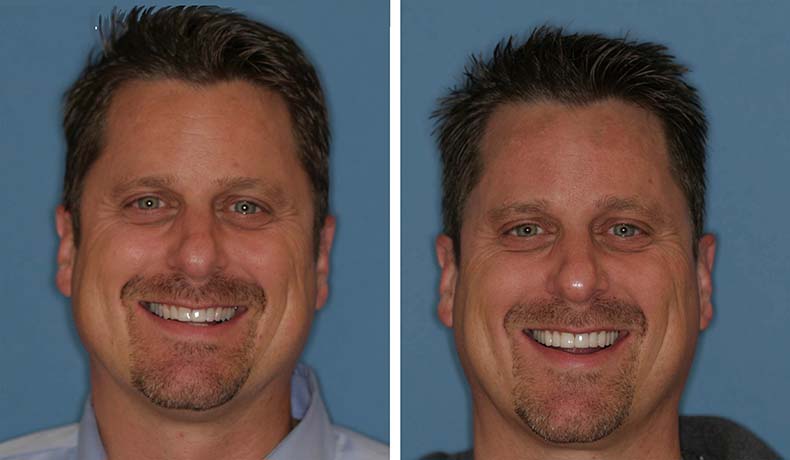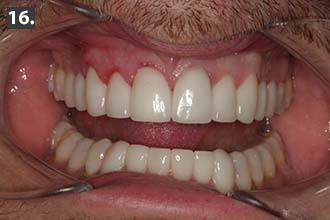- 651-738-1880
- 8380 City Centre Drive, Suite 130 Woodbury MN 55125-5304
As people get older, their teeth get worn out, making a person look older than they actually are. Most of these individuals end up having more issues with their overall occlusion, which result in their problems not being solved by just giving them some new veneers.
When their occlusion is really studied over, one realizes they may need their entire dentition restored. This ends up becoming a lot more than what most people have bargained for and when this is discussed, many people are blown away by the cost. So, we are put in a position of doing what is right or not doing anything at all. How many times do dental patients tell you, “Doc, just fix my front teeth. I know you can do it. I don’t care about my other teeth. Nobody can see them anyway.” And if you give in to their request, you unfortunately have created a situation that will most likely keep you up at night wondering when this patient is going to call you with a broken veneer that they say you did and asking why it broke.

FIGURE 1. Pre-operative view just after orthodontic appliance removal.
TMJ/Muscle Exam:The masseter muscles were tight on the left and right. The right TMJ was tender to palpation. In Centric Relation the first point of contact was tooth #18 and 31. When the patient squeezed his teeth together, he slid forward ½ mm into centric occlusion.
His range of motion was within normal limits, with 50mm max opening without deviation and left and right lateral movement to 13mm respectively.1
He had moderate to severe wear into the dentin with teeth #2,3,4,6,11,13,14,15,18,19,29,30 and 31. Mild wear with his remaining none restored dentition (Figs. 1 and 2). In reviewing his medical history, he did not have a history of stomach issues. He reported he maintained a healthy diet and was aware of avoiding acidic beverages. He had a deep overbite with a large curve of spee (Fig. 3) with working interferences on the distal buccal cusps of teeth #18 and 31.2
It was concluded the patient had attrition and subsequent erosion of the functional surfaces of his natural teeth. Since his medical history revealed he did not have any stomach issues, it was felt the primary cause was from para function. This was supported by the fact his anterior teeth were also deteriorating.4,5
Having all his posterior stops in dentin ruled out just doing an occlusal equilibration for his posterior teeth. Therefore, to create a stable, esthetic restorative result the patient needed his entire dentition restored. It was recommended to do the following:
* Teeth #2, 15,18,19,30 and 31: emax onlays
* Teeth #3, 4, 5,12,13,14,20,21,28 and 29: reverse ¾ crowns
* Teeth #6, 9 and 22 to 27: emax crowns
* Teeth #7, 8, 10: emax veneers6
At the end of treatment, fabricate a mandibular occlusal orthotic.
When this treatment plan was presented, the patient understood the reason for the plan but felt he could not afford to do the treatment all at once and requested a way to phase out this treatment plan over time. He agreed he could afford to do ten teeth. To help the patient achieve what he came in for, I needed to get creative on how we could meet his dental needs.
The lower ten anterior teeth is where I wanted to begin but to no surprise, the ten teeth the patient was willing to do were teeth #4-13. This left me the other 18 teeth to restore temporarily. Since one needs, to begin with restoring the lower I recommended to recontour the lower crowns to reduce the exaggerated curve of spee (Fig. 3). Then I could build chairside composite onlays to fill in and level the curve of spee in the posterior quadrants (Fig. 8). Once that would be completed then teeth #4-13 could be prepared. The vertical dimension was opened 1mm in the anterior to reduce the overbite and as a result teeth #7,8,10 had to be converted to ¾ emax crowns vs. veneers to establish occlusal stops on the lingual.
Before the restorative appointment a diagnostic wax-up was made for teeth #4-13 based on the smile design the patient approved (Fig 9). The lower stone model was recontoured from teeth. Then wax was added to teeth #18-21 and 28-31. The wax-up was duplicated (Figs. 10 and 11) and a clear polyvinyl matrix was made of the posterior quadrants to use as a chairside matrix for the composite onlays (Fig 12). Then a siltec putty matrix was made of the lower anteriors to use as a reduction guide.7
On the preparation day the entire treatment plan above needed to be performed to create a stable occlusion. After the administration of infraorbital blocks to anesthetize teeth #4-13, the siltec putty matrix was used to guide in the recontouring and polishing of the lower anterior porcelain crowns.
Diamond burs, 3-M soft flex discs, Brassler dialite porcelain polishing wheels were used in this respective order. To create the final polish, Brassler diaglaze with a Robinson wheel in a straight slow speed handpiece was used. Then using an Isolite, teeth #18 to 21 were isolated. The entire occlusal and half way down the buccal and lingual surfaces were pumiced, etched and primed with Optibond solo plus. One needed to be careful to not etch the interproximal surfaces. Once the bonding steps were completed, 3-M A-1 Filtek flowable composite was placed in the occlusal of the clear putty matrix. The matrix was then placed over #18-21, Retracted view one week post-op of final restorations.
16. held firmly and light cured for 20 seconds on each tooth. The clear matrix was simply removed and the composite flash was removed with a scaler. The margins were contoured and polished with carbide finishing burs and soft flex discs. Since the etch was carefully not placed in the interproximal the contacts were easily cleaned out and flossed. The procedure was then repeated for teeth #28-31.8
Now that the entire lower arch is developed with an ideal occlusal scheme the upper arch can now be restored and an ideal design can be created without any compromise. Teeth #4-13 were prepared and teeth #2, 3, 14 and 15 were equilibrated to balance with the newly established lower dentition (Fig. 13). After taking the final impressions the provisionals were fabricated based off the wax-up initially done by the laboratory (Figs. 14 and 15).9
The patient was followed up for the next two weeks to verify his the new smile design and that the new occlusion was balanced, comfortable and stable. The patient reported he was feeling good with his new occlusion and was very happy with his new smile design. After the two week “testing” period, the fabrication of the final restorations began following the model
of his provisionals. Four weeks later, the patient returned still feeling comfortable with his new occlusion.

The new restorations for teeth #4-13 were tried in, approved by the patient and subsequently bonded in. A mandibular occlusal orthotic was fabricated and delivered on the following appointment. He returned for follow-up appointments at one week, (Fig. 16) one month, one year and at two years (Figs. 16-21). He “loves” his new smile and plans on finishing the rest of his treatment plan.
At the two-year point, some occlusal wear was noted with the posterior composite onlays. But the author felt these composite onlays were far more stable than trying to maintain long-term acrylic provisionals. There wasn’t one emergency appointment for a lost composite onlay versus the likelihood of acrylic provisionals periodically coming off. Also, the long-term tissue health was stable due to normal flossing contacts between all 28 teeth. When the patient is ready each posterior quadrant can be restored in phases or all at once if the patient so elects.
The flexibility is built into the case. And as the practitioner, you can sleep well at night knowing you haven’t compromised the final outcome due to the financial obstacles the patient initially presented you with. Following the above concept, you can get to the final destination and look back on the “road trip” and realize it was a fun, predictable (financially and clinically) and everyone was happy when they got there.